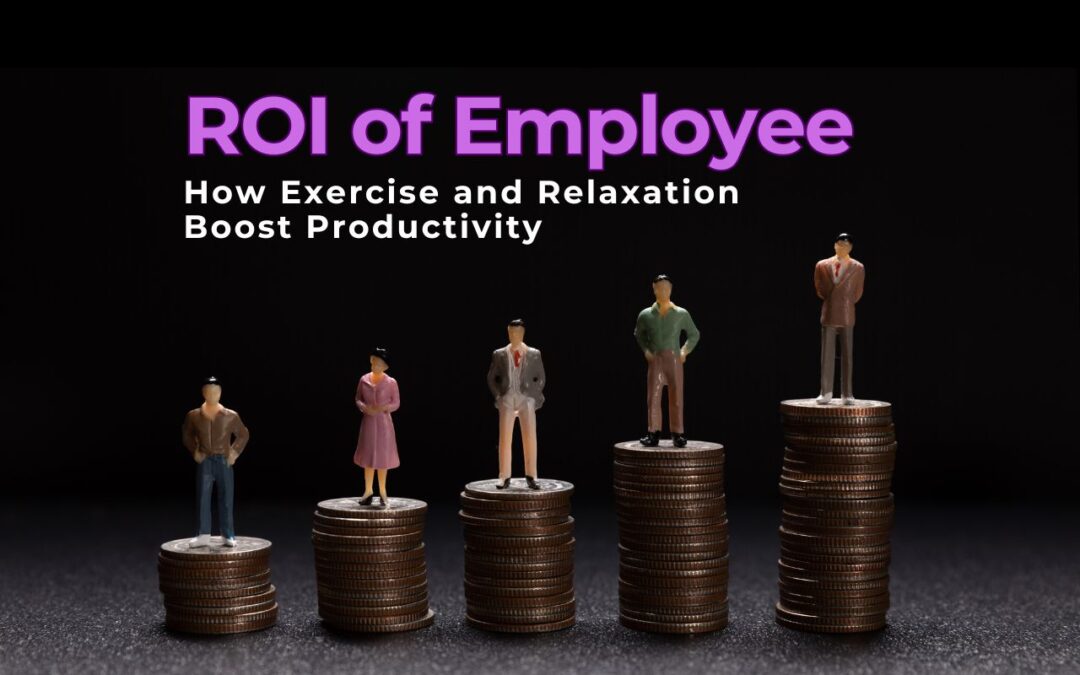In an era where ROI of Employee retention, productivity, and workplace culture are critical to organizational success, the idea of investing in employee wellness is gaining momentum. What was once considered a luxury perk has now become a key strategy for boosting company performance and employee satisfaction. In this comprehensive guide, we’ll explore how exercise and relaxation, the core components of wellness, translate into tangible business outcomes—and why prioritizing them yields measurable returns on investment (ROI).
Introduction: Why Employee Wellness Matters Now More Than Ever
The modern workplace is more demanding than ever, with longer work hours, high performance expectations, and digital burnout becoming commonplace. As employees juggle multiple responsibilities and face growing mental health challenges, employers are realizing the cost of doing nothing.
According to the American Institute of Stress, job stress is the major source of stress for American adults and has escalated over the past few decades. Chronic stress leads to absenteeism, poor performance, and high turnover—each of which is a direct cost to the organization.
In this environment, companies that prioritize wellness are gaining a distinct advantage. Not only are they creating healthier workplaces, but they’re also seeing a positive impact on their bottom lines.
The Business Case for Wellness Programs
Organizations that invest in wellness programs typically experience:
- Reduced absenteeism
- Higher employee engagement
- Lower healthcare costs
- Improved productivity
- Greater talent retention
For every dollar spent on wellness programs, businesses see an average return of $1.50 to $4 in benefits. This ROI of Employee comes from decreased health care costs, fewer missed workdays, and enhanced productivity levels.
Additional Benefits:
- Stronger employer brand
- Greater team collaboration and morale
- Reduced workplace accidents
A Gallup study found that teams with high well-being scores have 41% lower absenteeism and 21% higher productivity.
The Science Behind Exercise and Productivity
Physical Benefits:
- Improves cardiovascular health
- Increases stamina and reduces fatigue
- Strengthens the immune system
Cognitive and Emotional Benefits:
- Releases endorphins (natural mood boosters)
- Enhances focus, memory, and mental clarity
- Reduces symptoms of depression and anxiety
A report from the Journal of Occupational and Environmental Medicine concluded that workers who exercised regularly were more productive and had better attendance records.
Even low-impact exercise—such as walking meetings or 15-minute office yoga—can lead to a boost in energy, better decision-making, and increased creative thinking.
The Power of Relaxation and Mental Clarity
Relaxation isn’t about laziness—it’s about recharging. When employees are overwhelmed, they lose clarity, motivation, and purpose. Integrating mental wellness practices into the workplace can change this.
Key Relaxation Techniques:
- Mindfulness meditation
- Breathwork and deep breathing
- Progressive muscle relaxation
- Power naps
- Gratitude journaling
Practicing mindfulness has been shown to reduce workplace errors, improve memory recall, and increase overall life satisfaction. Companies that implement mindfulness programs, such as Aetna and Google, report enhanced employee resilience and a drop in stress-related absenteeism.
Key Wellness Program Models That Work
Here are some popular models that companies of all sizes are adopting:
1. Onsite Fitness Programs
- Onsite gyms or partnerships with local fitness centers
- Group fitness classes (e.g., Zumba, Pilates, HIIT)
2. Remote Wellness Options
- Virtual yoga, meditation, and fitness classes
- Health tracking apps and gamified wellness challenges
3. Flexible Schedules for Self-Care
- Longer lunch breaks to fit in workouts
- Four-day workweeks or remote Fridays
4. Mental Health Support
- Access to therapists and counselors
- Employee Assistance Programs (EAPs)
5. Holistic Wellness Initiatives
- Healthy snack options in break rooms
- Wellness retreats and mental health days
ROI Metrics: How to Measure the Impact
To justify continued investment, companies need to track key performance indicators (KPIs), such as:
- Reduction in absenteeism and presenteeism
- Health care claim savings
- Employee satisfaction and engagement surveys
- Employee retention rates
- Productivity benchmarks (output per hour, task completion rates)
Tools like wearable fitness trackers, digital wellness dashboards, and annual health screenings make it easier to gather wellness data and connect it to performance.
Case Studies: Companies Winning with Wellness
1. Google
Provides nap pods, meditation rooms, fitness centers, and nutritious food. Result: Lower attrition and higher innovation rates.
2. Johnson & Johnson
Wellness initiatives led to a $250 million savings in health care costs over a decade, with a $2.71 return for every dollar spent.
3. Microsoft Japan
Implemented a 4-day workweek pilot and saw a 40% increase in productivity.
4. Aetna
ROI of Employee who participated in wellness programs gained 62 minutes of productivity per week, translating to $3,000 in increased annual productivity per employee.
Common Challenges and How to Overcome Them
Challenge 1: Low Participation Rates
Solution: Offer personalized wellness options and incentivize participation with rewards.
Challenge 2: Lack of Budget
Solution: Start small. Walking challenges, online yoga, or mental health awareness campaigns are low-cost, high-impact ideas.
Challenge 3: Leadership Buy-In
Solution: Present data on ROI of Employee and tie wellness outcomes to company goals like retention, innovation, and productivity.
Challenge 4: Remote and Hybrid Workforces
Solution: Use digital platforms to deliver wellness content and encourage virtual participation.
Cost-Effective Wellness Strategies for Small and Medium Businesses
SMBs often shy away from wellness due to perceived costs. However, there are budget-friendly options:
- Host monthly wellness workshops
- Encourage walking meetings
- Provide free access to meditation apps like Calm or Headspace
- Offer flexible work hours to accommodate exercise
- Use surveys to understand employee needs and act on the feedback
Even minor initiatives like healthy snack bowls, hydration reminders, and desk stretching guides can create a positive ripple effect.
Future Trends in Workplace Wellness
1. Personalization through AI
Custom wellness plans using AI to tailor activities based on biometrics and behavior.
2. Mental Fitness as a Priority
Mental health will become as important as physical health, with training in emotional intelligence, resilience, and psychological safety.
3. Nature-Based Wellness
Biophilic design, outdoor workstations, and nature retreats are gaining popularity for their restorative effects.
4. Preventive Wellness Programs
Early screening and proactive health coaching to catch issues before they affect work performance.
5. Gamification
Integrating wellness into games and team challenges to boost participation and fun.
Conclusion: Make Wellness Your Competitive Advantage
Wellness is not just about reducing sick days—it’s about creating an empowered workforce that thrives. Organizations that support wellness see better employee engagement, higher productivity, and a stronger employer brand.
By weaving wellness into your company culture through exercise, relaxation, and mindful leadership, you’re not only investing in your employees—you’re investing in your future. As the workplace continues to evolve, employee wellness will become one of the most powerful levers for sustained business success.
So start today. One step at a time. One breath at a time. Because a healthy employee is a productive employee, and a productive employee drives your ROI forward.












